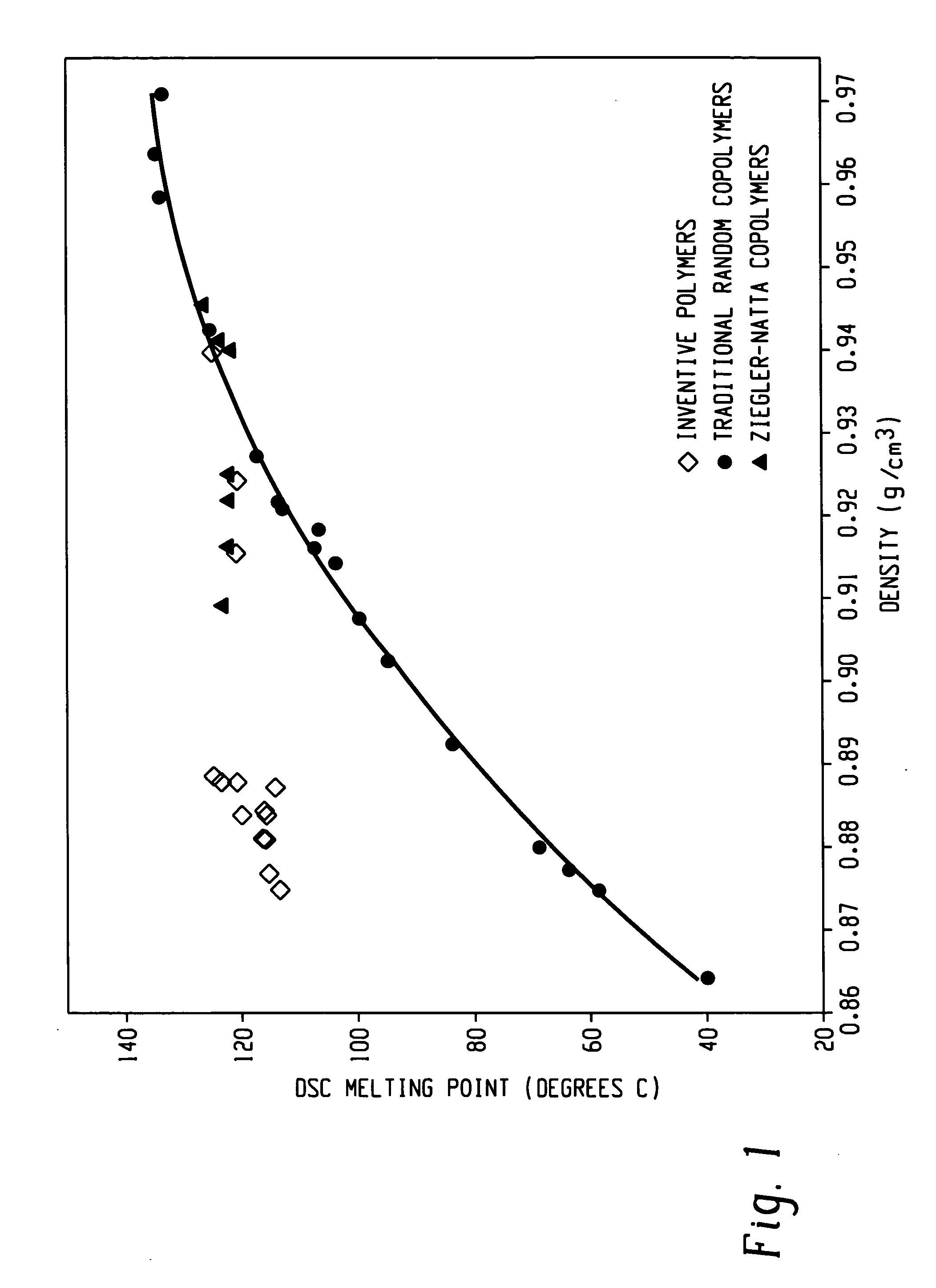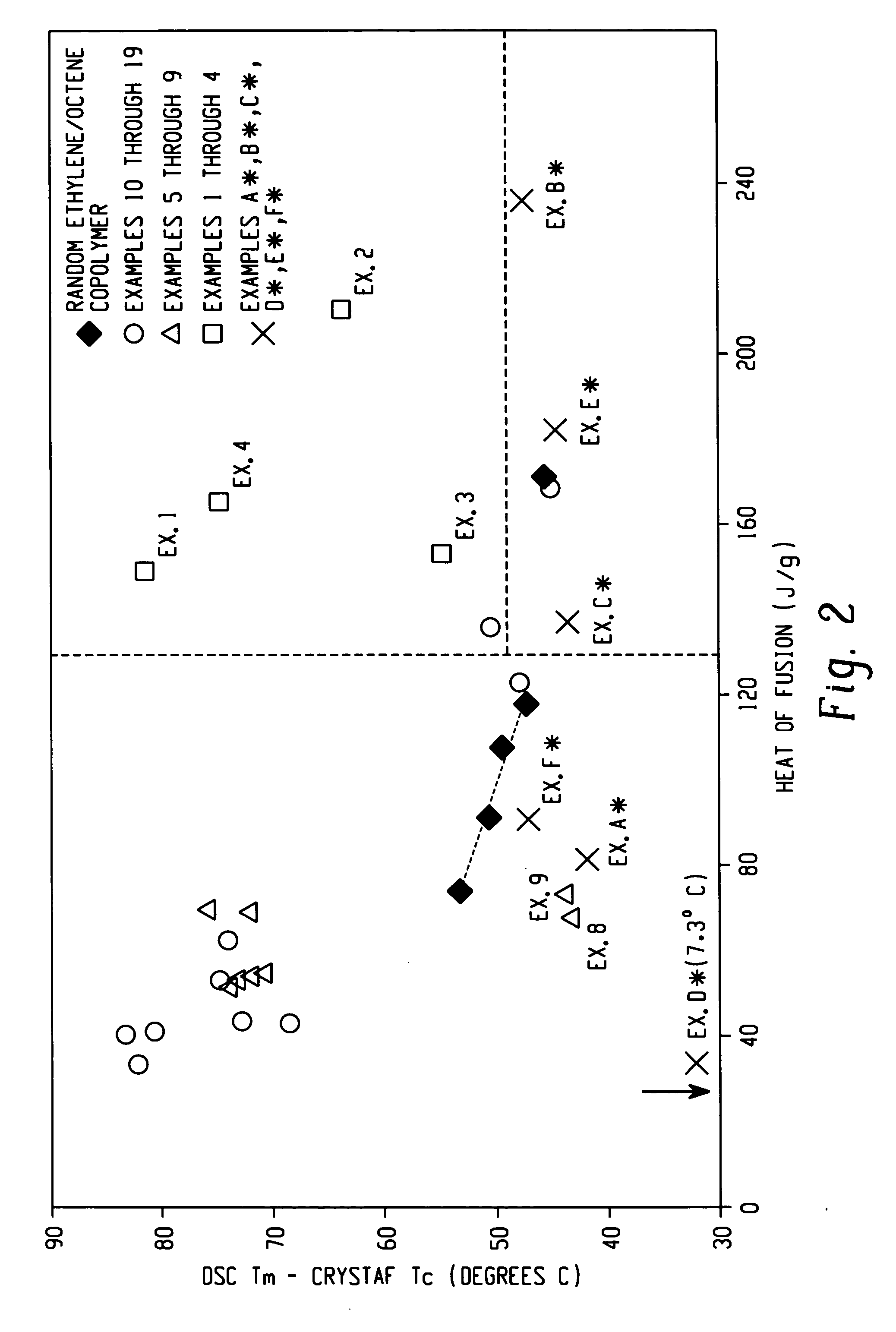Viscosity index improver for lubricant compositions
a technology of viscosity index and lubricant composition, which is applied in the direction of lubricant composition, pharmaceutical delivery mechanism, organic dye, etc., can solve the problems of poor thickening efficiency at high temperatures, relative high cost of hydrogenated styrenic block copolymer, and limited useful li
- Summary
- Abstract
- Description
- Claims
- Application Information
AI Technical Summary
Benefits of technology
Problems solved by technology
Method used
Image
Examples
examples
[0161] Testing Methods
[0162] In the examples that follow, the following analytical techniques are employed:
GPC Method for Samples 1-4 and A-C
[0163] An automated liquid-handling robot equipped with a heated needle set to 160° C. is used to add enough 1,2,4-trichlorobenzene stabilized with 300 ppm Ionol to each dried polymer sample to give a final concentration of 30 mg / mL. A small glass stir rod is placed into each tube and the samples are heated to 160° C. for 2 hours on a heated, orbital-shaker rotating at 250 rpm. The concentrated polymer solution is then diluted to 1 mg / ml using the automated liquid-handling robot and the heated needle set to 160° C.
[0164] A Symyx Rapid GPC system is used to determine the molecular weight data for each sample. A Gilson 350 pump set at 2.0 m / min flow rate is used to pump helium-purged 1,2-dichlorobenzene stabilized with 300 ppm Ionol as the mobile phase through three Plgel 10 micrometer (μm) Mixed B 300 mm×7.5 mm columns placed in series and ...
examples 1-4
, Comparative Examples A*-C*
General High Throughput Parallel Polymerization Conditions
[0204] Polymerizations are conducted using a high throughput, parallel polymerization reactor (PPR) available from Symyx technologies, Inc. and operated substantially according to U.S. Pat. Nos. 6,248,540, 6,030,917, 6,362,309, 6,306,658, and 6,316,663. Ethylene copolymerizations are conducted at 130° C. and 200 psi (1.4 MPa) with ethylene on demand using 1.2 equivalents of cocatalyst 1 based on total catalyst used (1.1 equivalents when MMAO is present). A series of polymerizations are conducted in a parallel pressure reactor (PPR) contained of 48 individual reactor cells in a 6×8 array that are fitted with a pre-weighed glass tube. The working volume in each reactor cell is 6000 μL. Each cell is temperature and pressure controlled with stirring provided by individual stirring paddles. The monomer gas and quench gas are plumbed directly into the PPR unit and controlled by automatic valves. Liquid...
examples 20-23
Ethylene / α-olefin Interpolymers
[0254] Polymer Examples 20-23 were prepared under reaction conditions substantially similar to those for polymer Examples 1-19. One skilled in the art knows how to manipulate process conditions, such as shuttling agent ratios, hydrogen flow, monomer concentration, etc., to make a target polymer with desired properties using the process conditions already detailed in the instant application. Properties for the polymers of Examples 20-23 are shown in Tables 10A and 10B.
TABLE 10AProperties of exemplary polymersOverallMol %Heat ofPolymerDensityButeneMwMnFusionExample No.(g / cc)I2 @ 190 C.I10 @ 190 C.I10 / I2(NMR)(g / mol)(g / mol)Mw / Mn(J / g)200.87780.96.397.0123600593002.157210.86521.17.486.814.6124900607002.127220.86661.17.206.417.793400469002.040230.86411.06.406.417.8113400577002.04423A0.87950.96.046.615.1115700505002.36123B0.88021.17.426.8NM112200372003.063
[0255]
TABLE 10BProperties of exemplary polymersATREFOverallCRYSTAFPeakPolymerOverall wt %heat ofTCRYSTA...
PUM
| Property | Measurement | Unit |
|---|---|---|
| Temperature | aaaaa | aaaaa |
| Temperature | aaaaa | aaaaa |
| Temperature | aaaaa | aaaaa |
Abstract
Description
Claims
Application Information
 Login to View More
Login to View More - R&D
- Intellectual Property
- Life Sciences
- Materials
- Tech Scout
- Unparalleled Data Quality
- Higher Quality Content
- 60% Fewer Hallucinations
Browse by: Latest US Patents, China's latest patents, Technical Efficacy Thesaurus, Application Domain, Technology Topic, Popular Technical Reports.
© 2025 PatSnap. All rights reserved.Legal|Privacy policy|Modern Slavery Act Transparency Statement|Sitemap|About US| Contact US: help@patsnap.com



